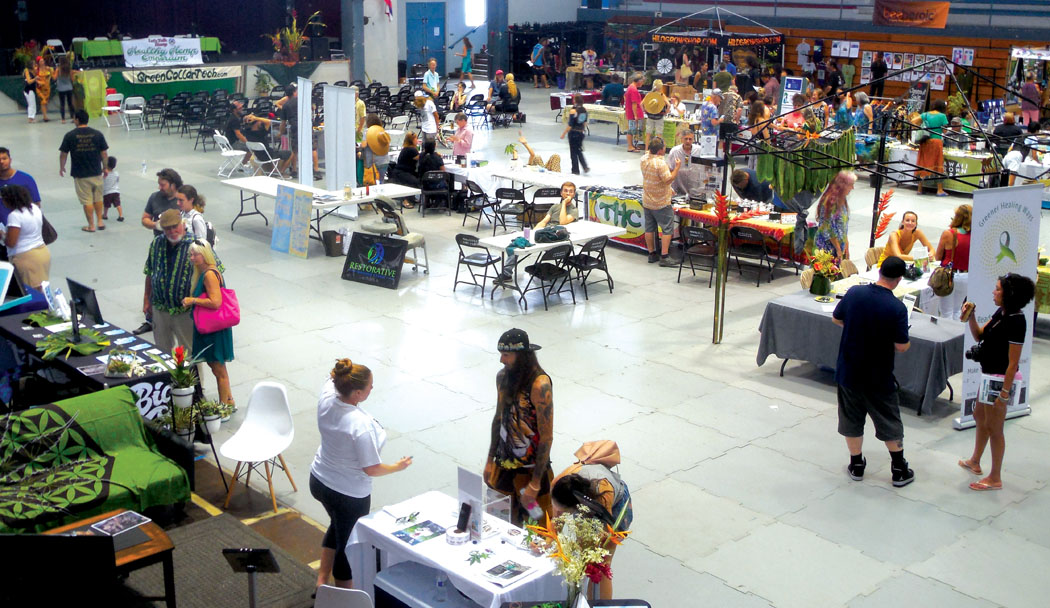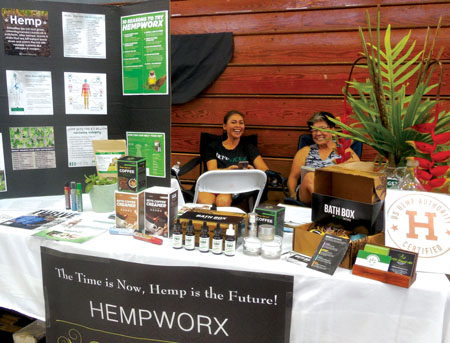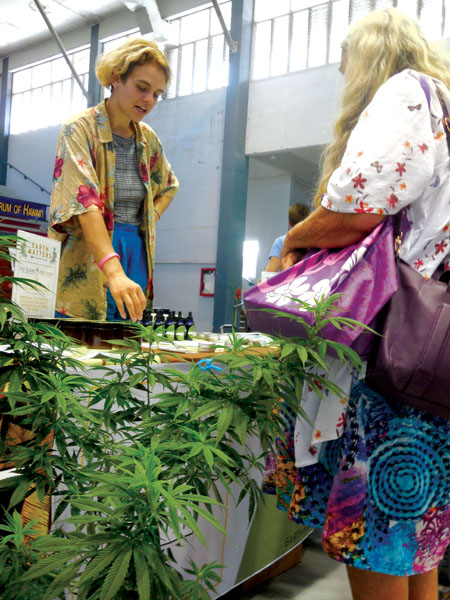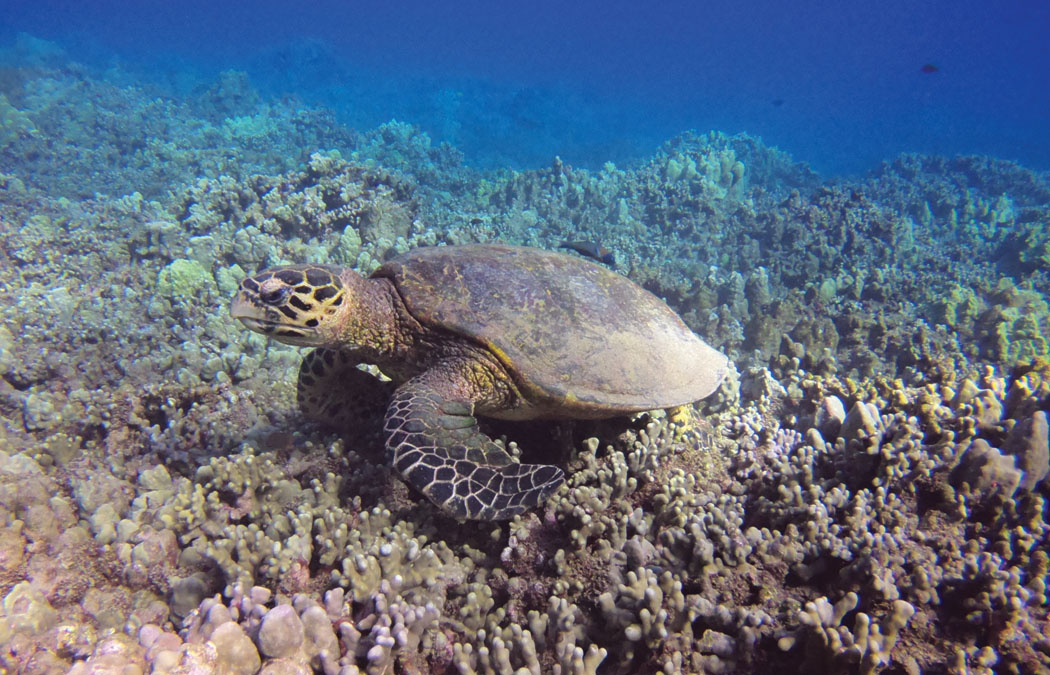
Seeds of a New Industry: A History of Cannabis on Hawai‘i Island
Editor’s Note:
Our local agriculture feature story was originally planned to cover the production of Hawai‘i’s legal cannabis crop. However, due to circumstances beyond our control, we were unable to pursue it. Instead, here is an overview and history of cannabis on the island. We will publish another story on other uses of cannabis in a future issue.

By Stefan Verbano

During a weekend last June, cannabis connoisseurs of every stripe met at the Afook-Chinen Civic Auditorium in Hilo to celebrate the many uses of this enduring plant. At the Hawai‘i Cannabis Awareness Conference, vendors displayed everything hemp: weed-leaf-print apparel, homemade cannabis oil presses, sample packets of nutritious shelled hemp seeds, CBD oil, shampoo, soaps, chocolates, snacks, even dog treats. It was a small yet deliberate group of forward-thinking entrepreneurs nonplussed by the continued federal classification of cannabis as a dangerous drug.
There was dancing in the aisles between panel discussions, and a palpable excitement about what kinds of opportunities this new industry could bring its producers. Their efforts were at last becoming legitimate businesses. “Come meet your friends and future business partners,” the conference literature touted.
Among the conference-goers was Mike Ruggles. Mike’s medical cannabis co-op known as the Alternative Pain Management Pu‘uhonua’s Collective in Fern Acres was raided in September 2015. The 150-member collective served as a means for patients and members to offload excess cannabis by transferring it to other members. This allowed them to comply with the State’s quantity restrictions while still maintaining an uninterrupted supply of safe, legal, potent medicine.
The Past

Operation Green Harvest began on Hawai‘i Island as an undercover federal, state, and local narcotics operation in the late 70s, with heavily armed officers conducting full-fledged, military-style smash and grab assault runs on illegal cannabis operations using police and National Guard helicopters. They would either blast contraband weed patches with herbicide from helicopter-mounted sprayers, or officers would physically uproot the plants and attach them to the helicopter in bundles, to be flown to the nearest accessible road and offloaded onto flatbeds trucks, then driven to secret landfills and dumped.
Billions of dollars worth of cannabis rotted. At Green Harvest’s apex in 1987, it confiscated 1.9 million plants. An industry that once surpassed the value of sugar, pineapples, and tourism combined—estimated to be worth between $1 billion and $10 billion—withered up like the plants it was built upon. The price of street cannabis soared, creating a supply vacuum that gave rise to cheaper, more damaging, and much more addictive hard drugs like crystal methamphetamine (known locally as “ice” or “batu”), black-tar heroin, and cocaine. A popular bumper sticker in the archipelago at the time read: “Thanks To ‘Green Harvest,’ Our Island’s On ‘Ice’.”

Green Tide Begins to Turn
For three decades, Green Harvest helicopters roamed Hawai‘i Island, and for three decades Hawai‘i taxpayers footed the bill. Then community members finally decided to fight back. In 2008, Hawai‘i County passed the “Lowest Law Enforcement Priority of Cannabis Ordinance” by the slimmest of margins—53%. With the ordinance enacted, the island joined other progressive, civil rights-minded jurisdictions like Seattle (2003), Oakland (2004), Santa Barbara, Santa Cruz, San Francisco, Santa Monica (2006), and Denver (2007), all of which had passed similar measures in previous years either through voter initiatives or elected officials’ actions. To follow these new rules, local police would have to use their resources combating violent crime and hard drugs first before spending any money on cannabis enforcement.

The language of Hawai‘i Island’s own ordinance dealt a deathblow to Green Harvest in no ambiguous terms, asking federal and state enforcement agencies to simply stop.
“The citizens of the County of Hawai‘i have passed an initiative to make Cannabis offenses the Lowest Law Enforcement Priority, where the Cannabis is intended for adult personal use, and request that the federal and state branches of government remove criminal penalties for the cultivation, possession and use of Cannabis for adult personal use; the citizens also request that Cannabis policies here within the County of Hawai‘i be dealt with from our local law enforcement only,” the ordinance reads.
The new law ended up being thrown out by the courts, and the helicopters continued, though now only a slight shadow of their former military might.
“We did not expect the initiative to hold up in court, but it spoke strongly of the will of the people,” says Andrea Tischler, the former Hawai‘i Island chair of Americans For Safe Access, a 100,000-member Washington, DC-based organization working to ensure safe and legal access to cannabis for medical and research purposes. Andrea continues, “The initiative ultimately made it easier and safer for Hawai‘i medical cannabis patients to obtain medicine.”
This was eight years after Hawai‘iʻs medical cannabis program was implemented in 2000, allowing the State Department of Health (DOH) to create a registry program for eligible patients whose doctors approved cannabis use as an appropriate treatment for their illnesses. With a DOH Registration Card, medical cannabis patients in Hawai‘i now had a certain degree of legal protection, at least at the local level. Currently, there are approximately 25,000 medical cannabis patients in the state, with about 7,000 of those residing on Hawai‘i Island.
Hawai‘i was the fifth state in the US to legalize medical cannabis after California (1996), Oregon, Alaska, Washington (1998), and Maine (1999), concurrently with Nevada and Colorado. In the 20 years since, every one of those states has legalized recreational cannabis except Hawai‘i. The island chain, it seems, lost much of its reform momentum a decade into the new millennium. Considering it was the first state in the US to legalize medical cannabis through a state legislature, today Hawai‘i ranks somewhere in the realm of Oklahoma in terms of pot-friendly “on the books” laws.
“Hawai‘i’s leaders demonstrated great wisdom and foresight 20 years ago,” Andrea says, “to have recognized the benefits and efficacious medical uses of cannabis, but they lost their vision and courage to advance from there.”

Still A Ways To Go
Andrea, after nearly a half-century of activism pushing for medical and personal cannabis use reform, says the islands are still not there yet.
“We’ve got a ways to go,” she says. ”The legislature is slow to change antiquated cannabis and drug policy laws, while the State Department of Health creates a bureaucratic maze of unnecessary and burdensome rules.”
Slow indeed. After medical use became legal, it took another 15 years for the State to pass laws allowing for medical dispensaries. More than three years after that, the first stores actually physically opened. In the nearly two decades in between, Hawai‘i cannabis patients could legally possess and consume their medicine; however, unless they grew it themselves or had a caregiver do so, every means of attaining it was still illegal. Even now, in 2019, with dispensaries open for business on main drags of larger Hawaiian towns, many patients are hardly any better off.

“They should have access to cannabis, which they do at dispensaries, but most people can’t afford it; the price of this medicine for people with low and fixed incomes is too high. They can’t afford the dispensary prices, so they end up going to the local pot grower,” Andrea says. “The dispensary system was set up to replace the black market. But most people can’t afford it, so theyʻre going to continue to buy it on the black market.”
Of the eight cannabis dispensary licenses statewide, Hawai‘i Island has two, held by the businesses Hawaiian Ethos and Big Island Grown, the latter being the only one currently with open storefronts in Hilo and Waimea, with another soon to open in Kona.
Prices for dried buds at the dispensaries can be more than $400 an ounce. By comparison, in Oregon where recreational cannabis is legal, ounces can go for a tenth of that. The high prices aren’t necessarily a result of greed or monopolies, although such accusations have been thrown around; rather, the startup costs of applying for a dispensary license, growing the plants in line with strict state regulations, paying for in-house quality and safety testing, and investing in brick-and-mortar retail space all inflate the price patients end up paying.
“If the State’s original goal with dispensary legislation in 2015 was—in the DOH’s own words—to ‘make medicinal products readily available for registered patients,’ then it has failed,” Andrea says. “As long as there are so few licensed outlets, it is always going to be unaffordable for most. Co-ops, collectives, and more retail businesses need to be established in the mix so that no patient is left out. Medicine prices will drop dramatically in a competitive market. The monopoly model must be broken.”
With the benefits of this natural medicine so obvious—and the uses of cannabis products including hemp so numerous—it’s difficult to understand why it has taken so long for Hawai‘i to achieve what other states have already accomplished. However, there is still hope for the islands. ❖
For more information: hawaiicannabis.org
Mahalo Ahualoa Farms–Local Agriculture Story Sponsor


